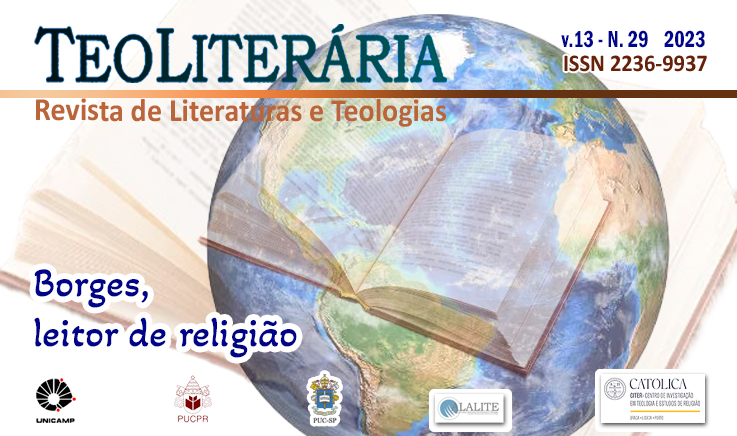O Livro de Areia e a Bíblia
Infinitude e inversões da Escritura em Borges
DOI:
https://doi.org/10.23925/2236-9937.2023v29p34-55Palabras clave:
O Livro de Areia, Jorge Luis Borges, Bíblia, apócrifos, leituraResumen
Este artigo procura pensar modelos de leitura de textos religiosos e, entre eles, da Bíblia, a partir da experiência da leitura em Jorge Luis Borges. A Bíblia é entendida como um texto potencial para a criação de textos, como um mundo de palavras que geram virtualidades, cuja função é alimentar as criações poéticas e de lhes potencializar a ficção. O texto religioso é dotado de polissemia, de forma análoga ao texto artístico, razão pela qual se encontrem, frequentemente, na zona fronteiriça entre arte e religião, na base da criação metafórica, nas características comuns do pensamento mitopoético, na estrutura do pensamento ficcional que subjaz a ambos. Ao destacar as conexões entre o texto religioso e o artístico e seguir dois dos fios puxados por Borges, a materialidade do texto e a abordagem microscópica, o artigo apresenta o conceito de texto e de leitura no relato O Livro de Areia, além de destacar como Borges interpreta textos bíblicos de forma direta, paródica e irônica, quando os relê na forma de fragmentos apócrifos.
Citas
Bíblia de Jerusalém. Nova edição, revista e ampliada. São Paulo: Paulus, 2002.
ECO, Umberto. A estrutura ausente. São Paulo: Perspectiva, 1971.
FLUSSER, Vilém. Elogio da superficialidade. O universo das imagens técnicas. São Paulo: É Realizações, 2019.
BORGES, Jorge Luis. Antologia pessoal. São Paulo: Companhia das Letras, 2008.
BORGES, Jorge Luis. Obras completas: Edición Crítica. Vol. I. Anotada por Rolando Costa Picazo e Irma Zangara. Buenos Aires: Emecé, 2009.
BORGES, Jorge Luis. Obras completas: Edición Crítica. Vol. II. Anotada por Rolando Costa Picazo. Buenos Aires: Emecé, 2010.
BORGES, Jorge Luis. Obras completas: Edición Crítica. Vol. III. Anotada por Rolando Costa Picazo. Buenos Aires: Emecé, 2011.
FRYE, Northrop. Anatomia da crítica. Quatro ensaios. São Paulo: É Realizações, 2014.
PAULS, Alan. El fator Borges. Barcelona: Anagrama, 2004.
STEINER, George. Tigres no espelho e outros textos da revista The New Yorker. São Paulo: Globo, 2012.
Publicado
Cómo citar
Número
Sección
Licencia
Derechos de autor 2023 Teoliteraria - Revista de Literaturas y Teologías (On Line) ISSN 2236-9937

Esta obra está bajo una licencia internacional Creative Commons Atribución 4.0.
La Teoliteraria - Revista Brasileira de Literaturas e Teologías es detentora de los derechos autorales de todos los artículos publicados por ella. La reproducción total de los artículos de ésta revista en otras publicaciones, o para cualquier otro fin, por cualquier medio requiere autorización por escrito del editor de este periódico. Reproducciones parciales de artículos (resúmenes, abstrac, más de 500 palabras de texto, tablas, figuras y otras ilustraciones) deberán tener permiso por escrito del editor y de los autores.

